So you are thinking about learning how to ride a horse, by learning to ride DIY style in other words on your own.
Maybe you just want to learn on your own, or you have a horse to ride but can’t afford lessons or you have a horse to ride but there are no riding instructors close enough.
You might be wondering if this is possible. And if it is, how to go about teaching yourself to ride.
Can I Teach Myself To Ride A Horse?
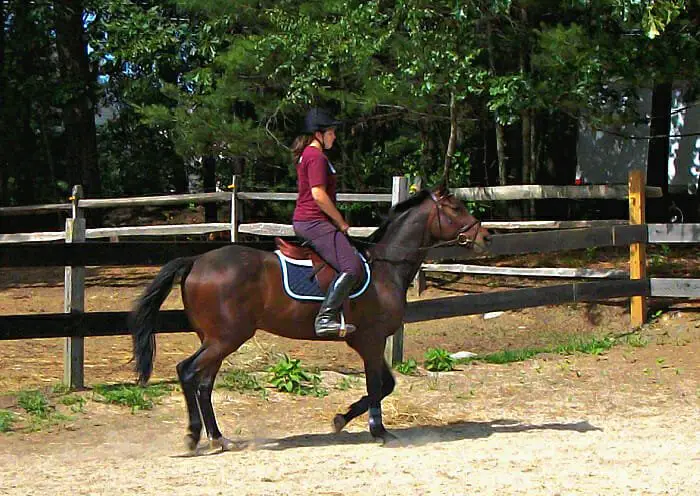
It is possible to successfully teach yourself how to ride a horse. Learning to ride on your own will mean a longer period of time for you to learn to ride well. You will be taking more risks. You may unintentionally hurt the horse or cause discomfort more often than if you have an experienced guide.
It will be a harder journey with more risks but still possible with the right person and many people have gone on this journey.
As a young child, I started learning to ride on my own. I would ride my cousin’s horses in the summers for a few years. I would also go on pony rides and trail riding during vacations whenever I got the chance. I read every horse book and magazine I could get my hands on.
It wasn’t until a few years later when I was 8 years old that I started taking horseback riding lessons. I have had periods of time taking lessons, working lessons off as a working student, and leasing and owning horses while both taking lessons and not.
I have found that taking lessons is the most ideal scenario for horse and rider. But that it is possible to improve and learn on your own.
I just want to mention that not being able to afford riding lessons is not a good excuse for not taking horse riding lessons. There were periods of time my parents couldn’t afford to pay for lessons and I found barns that let me work the riding lessons off.
However, I understand there are situations where that may not be an option.
Buying A Horse & Learning On Your Own Or Taking Riding Lessons
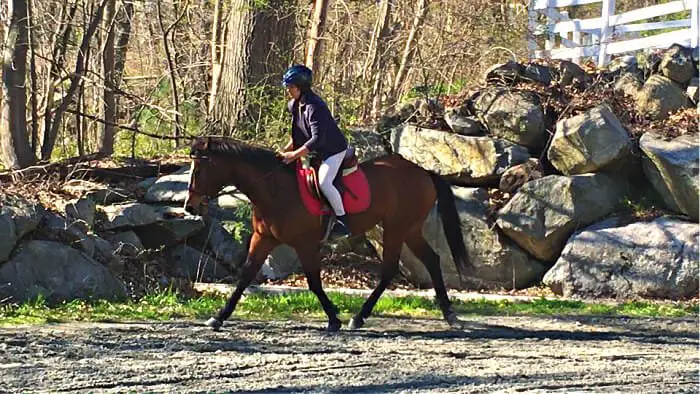
As a beginner rider if you have the option to own a horse or taking regular riding lessons. It would be for the benefit of yourself and your future horse that you post pone owning a horse and take riding lessons for a few years.
Along with riding lessons you should learn as much about horses as possible. Some examples of things you should learn include:
- horse behavior
- proper handling
- safety around horses
- fitting equipment properly
- feeding and caring for horses
- basic first aid and when to call the vet
- hoof care
- basic training skills
Taking riding lessons will progress your skills much faster than on your own. You will have guidance and the instructor will be able to help you overcome obstacles you have in your riding and communication with horses.
You will be less likely to develop bad habits or rough ways of handling and riding horses.
If you want to own a horse someday it would also benefit you to volunteer or work at a barn for a period of time and consider leasing a horse to help determine if owning a horse is the right choice for you.
Related Post: How To Know You Are Ready To Buy A Horse
What You Need To Teach Yourself To Ride A Horse?
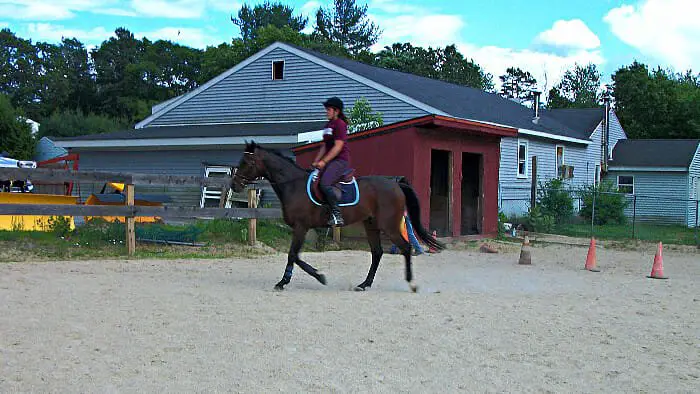
If money is the issue I suggest you find a barn where you can work off the riding lessons or take lessons less frequently like once every other week instead of 1-2 times per week.
The more you can ride and take lessons the faster you will be able to progress.
If you are set on learning by yourself then you want the right things to make the experience as successful as possible.
So here is a checklist of things I suggest you have for learning to ride by yourself. Some are obviously needed whereas some others are really good to have.
- A horse available to ride suitable for a beginner
- properly fitted tack for the horse.
- small enclosed arena, round pen, or small rideable paddock
- safe riding attire
- horse riding books, online courses, magazines
- video camera for filming your rides
- compassion and empathy towards animals
- tons of patience and a willingness to take things slowly
- grit and determination
- willingness to learn the hard way
- willingness to learn and train to continually become a better equestrian
How Long It Will Take You To Learn How To Ride
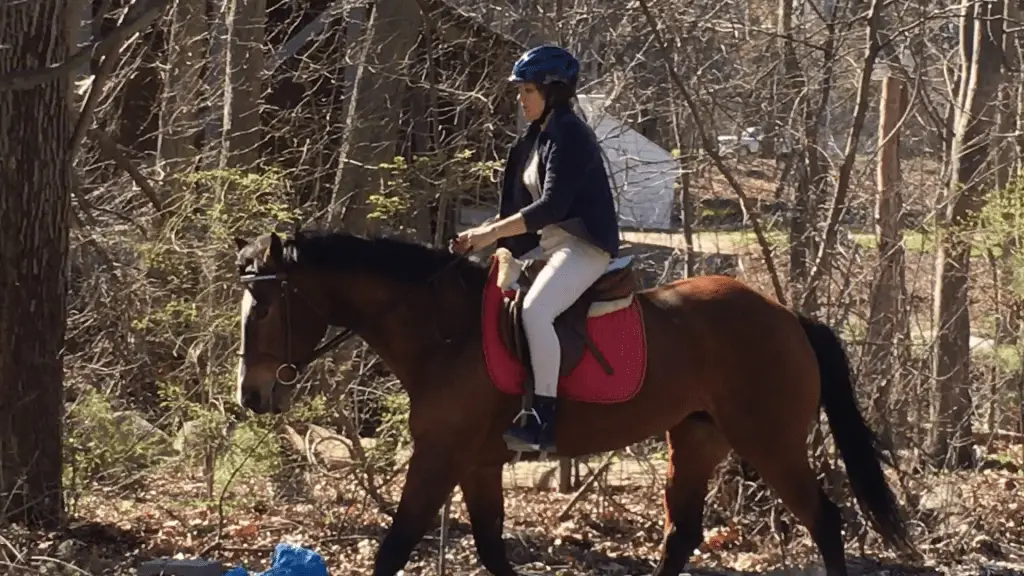
From my experience as a riding instructor with many, first time and beginner riders, it typically takes 2 years of regular weekly lessons to become competent at the basics of riding. This is just an average timeline. Some riders will progress faster and some slower.
How long it takes to get good at the basics of riding will vary based on the situation and the rider.
If you are learning on your own it is going to take longer than on average to get good at the basics of riding. You will be responsible for all the time needed for research and learning and then applying what you learn.
Examples of different factors affecting how long it takes to become competent at the basics:
- learning ability
- athletic ability
- fitness level
- confidence level
- coordination
- determination
- problem-solving ability
- understanding of the horse
- the horse you are riding
- riding area available
- The course, books, and blogs you choose to learn from
15 Tips For Teaching Yourself To Ride A Horse
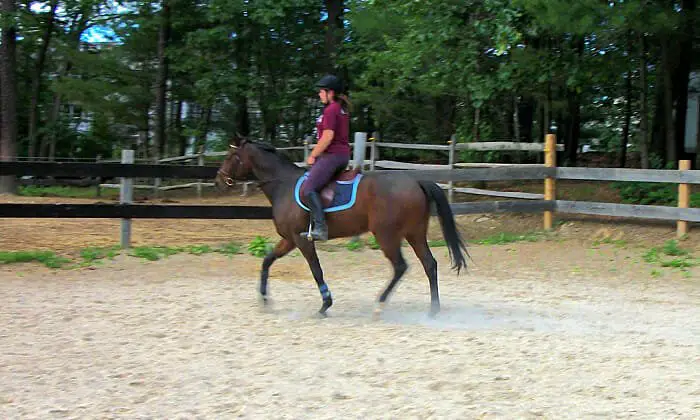
Before you start working with a beginner-friendly horse. You need to learn as much as you can and prepare yourself.
Related Post: How To Improve Your Riding Without A Horse: 13 Fantastic Ways
Here’s are some tips you can follow when teaching yourself to ride.
- Read a few good books on horseback riding, horsemanship, and horse care. Make sure you study them carefully. Related Post: 10 Must-Read Horse Books For Getting Started As An Equestrian
- Watch YouTube videos such as riding lessons, riding tutorials, riding critiques, and other informative horse videos.
- When your ready take an online riding course. You may need to do the course while you have actually started riding and working with your horse.
- When you begin to ride make sure you have someone around in case of emergency. As a beginner, you should never be totally alone. And even a more experienced rider can end up hurt or in an emergency situation.
- Start off riding in a smaller area, such as a round pen or a smaller paddock that has a decent footing. You want to have a smaller enclosed space so the horse is discouraged from getting quick or having enough space to gallop.
- Take videos of your rides so that you can evaluate your riding and compare it to more experienced riders. I have the Pixio Robotic Camera (This is an affiliate link if you click through and decide to purchase one yourself then I will get a commission that helps me be able to keep this blog going thanks!). It is a pain, in the beginning, to set up. But it is awesome for filming yourself when you have no one else to film you.
- Take your time don’t rush to the next thing to learn.
- If your horse is not responding how you want, don’t get rough or lose your temper. Most of the time the horse doesn’t understand what you are asking and is confused. Often this happens because of conflicting signals, the signals were not clear enough or the horse doesn’t know the signals you are using.
- Expect yourself to wonder “why does he do this?” often! There will be a lot of trying to figure out why your horse does certain things. Don’t assume… actually investigate and figure it out. Get online ask questions to experienced riders, read books, research on the internet. There is a wealth of information out there. One of the worse things you can do is makeup why the horse is doing something in terms of how a human would think. Horses do not think the same way as humans. Learn about horse behavior and instincts.
- If you lose your temper with the horse. Get off and walk around. Take a break. Don’t take your anger and frustration out on the horse. It will damage the relationship and trust the horse has with you.
- Use horse forums online to ask questions. Not as ideal as a riding instructor but the community can be helpful sometimes. Expect different opinions. Research online and look further into the advice these people offer you.
- If you can send videos once and a while to an instructor online and have your riding evaluated by video. The instructor may have suggestions or exercises you can work on to improve.
- Keep a riding journal to keep track of your progress. To highlight what is working, what’s not. What you are doing well and what you need to work on. I have a super awesome comprehensive riding lesson journal coming out but will be creating more journals in the future, such as a riding journal for riding on your own.
- Learn from the horse. Pay attention to what works and what doesn’t. The horse will let you know when they understand or don’t. They also learn what they are allowed to do and not allowed to do. You have to figure out the difference when the horse doesn’t want to do something and when they actually don’t understand what you are asking.
- Groundwork will help your riding. This will build your relationship and trust with the horse, build your confidence, and build better communication with the horse.
Related Post: The Ultimate Beginner’s Guide: How To Ride A Horse (By A Riding Instructor)
The Problems With Teaching Yourself To Ride
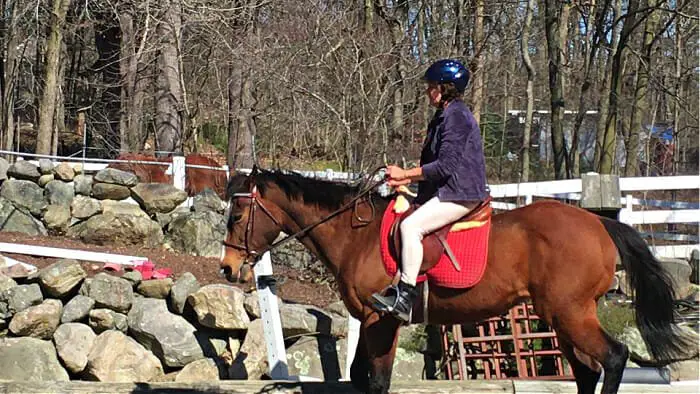
Just to prepare you and to be objective let’s look at the problems with teaching yourself to ride horses.
- You have no eyes from the ground to correct you when you are doing something wrong. For example, telling you when your position is off, such as you are leaning too far forward, your reins are too short or long, your heels are up, you need to sit up straighter and open your shoulders wide.
- You can hit roadblocks and plateaus in your riding more frequently.
- Your horse may learn bad habits just from your lack of skill or lack of knowledge. Sometimes bad habits can be a nuisance or get to the point where they become dangerous.
- This is reiterating the previous point in another way. Horses can lose there training or become rusty. At a lesson barn where horses are ridden by many beginners, they are also ridden by the trainer or experienced riders to retrain or tuned up there training. A really well-trained horse can become difficult if the horse’s training is not maintained or they are taught that it is acceptable to do things they should not. As horse handlers and riders no matter your level you are training or teaching the horse.
- You may cause your horse more pain and discomfort without guidance in your riding. For example, pulling the reins too hard, jerking on the reins, or using the reins for balance can hurt the horse’s mouth. Riding in an incorrect position, getting left behind the motion, and bouncing can cause pain in your horses back.
- If you are inexperienced you may not notice if the horse is lame and needs to see the vet or have time off. Learning to spot lameness and discomfort in a horse is something important for you to learn if you are learning to ride on your own. Even subtle lameness should be taken into consideration and at least a call to the vet. Horses as prey animals try there best to mask pain as an instinct so predators don’t see them as there next meal. Predators often go after injured animals.
- It will be a harder road. Harder for you and harder for the horse. The horse will have to put up with a lot more newbie mistakes than it would in a lesson with a vigilant instructor. You will have to learn by trial and error.
- You have more responsibility to take the time to study and learn how to do things properly with hardly any guidance.
- You may move onto the next exercise, skill, or gait before you are ready and risk losing your confidence, getting frustrated, frustrating your horse, getting hurt yourself, or hurting the horse. Having a riding instructor helps to keep you moving forward in your learning at the right pace. Not moving on to something new that you are not ready for. Not moving on before you are ready is not only for your sake but also for the horse’s sake.
The Risks With Learning To Ride On Your Own
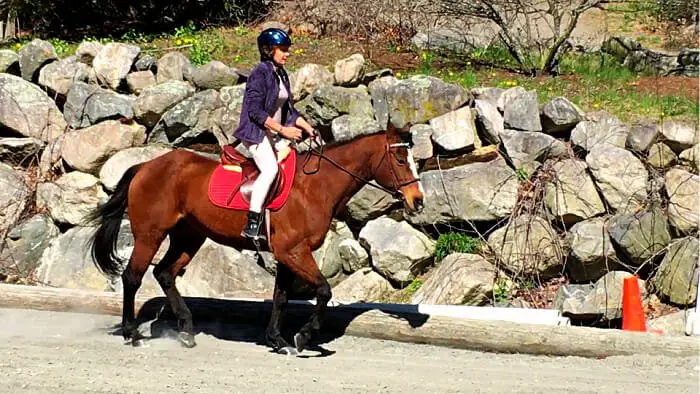
When you are handling horses and learning how to ride on your own. You put yourself at a higher risk. Horses can be dangerous. If you can’t read a horse’s body language well and understand how the horse is feeling that can be a problem.
- You may not know the horse is on high alert about to spook or bolt.
- You may not realize the horse is having a frisky day and might buck.
- You may not see the warning signs the horse is giving you to stay away and get kicked or bitten.
- You may not know the saddle is not fitting properly or is not properly placed causing the horse discomfort.
Many times horses act out badly when they are afraid or in pain.
Horses are big, fast animals and extremely strong. Though usually docile and willing they do have the ability to throw a person around like a rag doll.
It is essential you know safety practices around horses when handling horses and while riding.
One last thing is that you will have a higher chance of falling and injuries.
You will eventually fall off whether learning on your own or taking lessons. But you have more of a chance of falling off learning on your own.
Some examples of why you are at higher risk of falling:
- You may not understand the horse is about to do something that will put you off balance.
- Your riding position may not be the most balanced and secure.
- You don’t have an instructor telling you what to do when your horse starts bolting, bucking, or doing something that will most likely unseat you.
Overview Of Teaching Yourself To Ride Horses
Learning on your own without lessons there are things you can do.
- Reading books, manuals,
- online courses, magazines,
- watching riding lessons,
- going to horse shows, and
- watching horse shows,
- videoing yourself, and analyzing the video,
- watching instructors on video give riding lessons.
Horses are dangerous and learning on your own involves a higher risk of danger, but if you are:
- cautious
- slow
- good with problem-solving
- keeping a level head
- good at self-learning, researching
- empathetic
- and methodical
…you can be successful!
There are pros and cons to learning on your own with your own horse. So you need to decide if it is the right choice for you, for some, it could be the only choice.
Take every advantage you can get, to help you learn to ride well while do so as safe as you can and keeping the horse as happy as you can.
Feel free to comment any questions you have!
Happy horse riding and stay safe!
Cheers, Kacey

